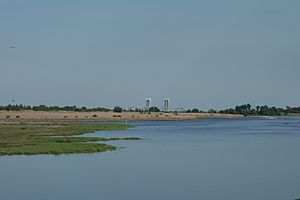Mau Mau Island facts for kids
Mau Mau Island, also known as White Island, is a small island in New York City. It's located in the borough of Brooklyn, within the Marine Park area. This island sits between two waterways, Gerritsen Creek and Mill Creek. It's a special place because no one lives there, and it's part of a larger park area.
Contents
What is Mau Mau Island?
Mau Mau Island is a small piece of land that wasn't always there. Long ago, the area around it was a "salt marsh." A salt marsh is a coastal wetland that is regularly flooded by ocean tides. The land here was always changing, like sand dunes shifting in the wind.
The island became a permanent feature after 1917. It most likely formed in 1934. This happened because people added extra soil and materials to the area. This process, called "dumping," helped create the island's current shape and shoreline.
Early History of the Island
For a long time, no European settlers lived in this specific area. This changed in the late 1700s. That's when a mill and a bridge were built nearby. These structures helped people use the waterways for trade and travel.
In the early 1930s, the island and much of Marine Park were given to New York City. Two important people, Alfred Tredway White and Frederic Pratt, made this donation. They had one main rule: the land had to be used as a park for everyone to enjoy.
Building Up the Island
More changes came to the island in the 1930s. Workers were building the Belt Parkway, a major road. They dug up a lot of sand during this construction. This extra sand was then added to Mau Mau Island.
After the sand was placed, patches of asphalt were laid on top. Asphalt is a dark, sticky material often used for roads. This was done to stop the sand from blowing away. It helped keep the sand from drifting onto the nearby Marine Park Golf Course.
Protecting Nature: Restoration Efforts
In 2011, the New York City Parks Department started an important project. They began working to restore Mau Mau Island. The main goal was to bring back the natural salt marsh environment.
This restoration also aimed to create better homes for birds. By restoring the salt marsh, they hoped to help many different bird species. This project helps protect the island's natural beauty and wildlife for the future.


